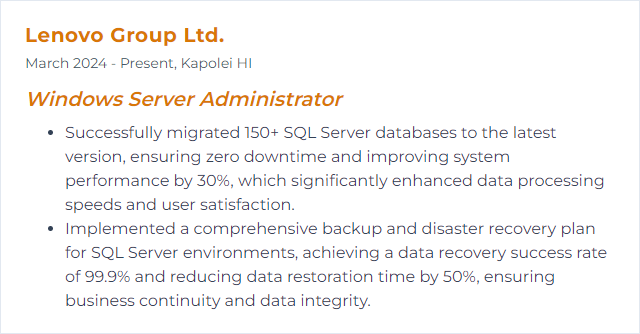Top 12 Windows Server Administrator Skills to Put on Your Resume
In today's competitive IT job market, standing out as a Windows Server Administrator requires showcasing a blend of technical prowess and soft skills on your resume. Mastering the right set of skills not only elevates your candidacy but also prepares you for the complex challenges of managing and maintaining Windows Server environments efficiently.
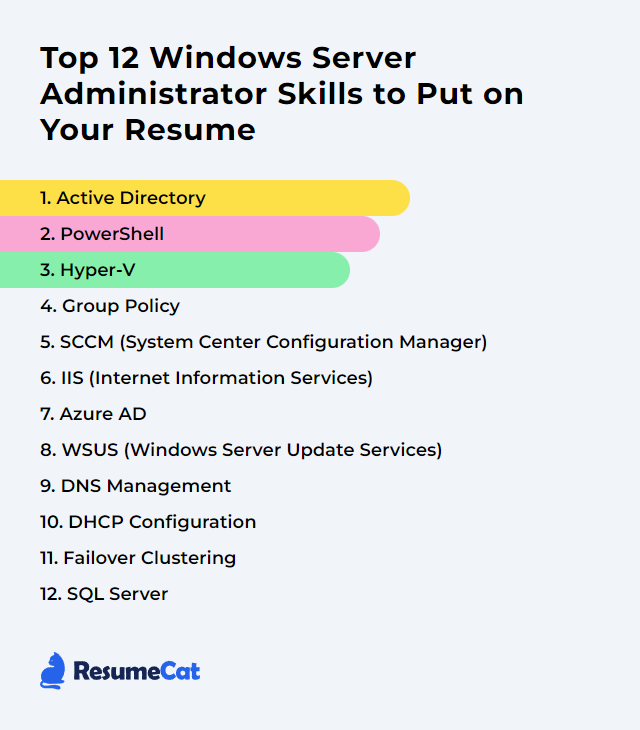
Windows Server Administrator Skills
- Active Directory
- PowerShell
- Hyper-V
- Group Policy
- SCCM (System Center Configuration Manager)
- IIS (Internet Information Services)
- Azure AD
- WSUS (Windows Server Update Services)
- DNS Management
- DHCP Configuration
- Failover Clustering
- SQL Server
1. Active Directory
Active Directory (AD) is a directory service developed by Microsoft for Windows domain networks. It enables centralized management of network resources, user accounts, and security policies.
Why It's Important
Active Directory (AD) is crucial for a Windows Server Administrator because it provides a centralized, secure framework for managing and controlling access to network resources, facilitating user and group management, and implementing security policies across Windows environments.
How to Improve Active Directory Skills
To improve Active Directory, a Windows Server Administrator should focus on enhancing security, performance, and manageability. Here's a concise guide:
Implement Strong Password Policies: Ensure that user accounts have strong password policies to defend against brute force attacks. Microsoft Docs - Password Policy
Regularly Update and Patch: Keep your Windows Server and Active Directory environments updated with the latest patches to protect against vulnerabilities. Microsoft Docs - Patch Management for Windows
Monitor Active Directory with Auditing: Enable auditing to track changes and detect suspicious activity. This helps in understanding what changes were made, by whom, and when. Microsoft Docs - Enable AD DS Auditing
Implement Least Privilege Access: Ensure that users have only the access that they need to perform their job functions, reducing the risk of internal threats and mistakes. Microsoft Docs - Principle of Least Privilege
Use Active Directory Administrative Tiering: Divide administrative tasks into tiers to limit the scope of access and reduce the risk of privilege escalation. Microsoft Docs - Administrative Tier Model
Backup and Disaster Recovery Plan: Regularly back up Active Directory and have a disaster recovery plan in place to minimize downtime and data loss. Microsoft Docs - AD DS Backup and Recovery
Implement Multi-Factor Authentication (MFA): Add an extra layer of security by requiring a second form of authentication. This is particularly important for privileged accounts. Microsoft Docs - Secure Privileged Access
Utilize Group Policy Object (GPO) Wisely: Manage and configure operating systems, applications, and user settings in an Active Directory environment efficiently. Microsoft Docs - Group Policy Overview
Keep Active Directory Organized: Regularly review and clean up outdated user accounts, groups, and Group Policy Objects to maintain an organized and efficient environment. Microsoft Docs - Managing Directory Objects
Educate Users: Train users on security best practices to help prevent social engineering attacks and to ensure they understand the importance of security measures. Microsoft Security Awareness Toolkit
By following these steps, a Windows Server Administrator can significantly improve the security, performance, and manageability of Active Directory.
How to Display Active Directory Skills on Your Resume
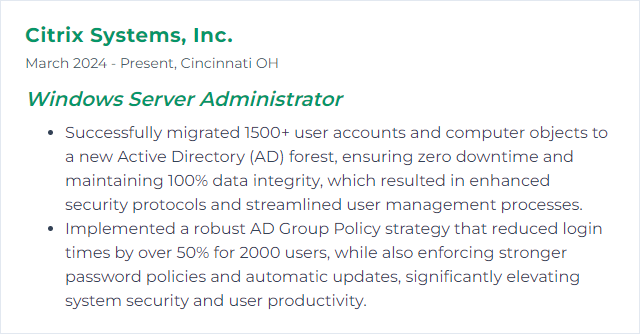
2. PowerShell
PowerShell is a cross-platform scripting language and command-line shell designed for task automation and configuration management, widely used by Windows Server Administrators to streamline administrative tasks, manage servers, and access a wide range of system functions through cmdlets and scripts.
Why It's Important
PowerShell is crucial for a Windows Server Administrator because it enables efficient automation of administrative tasks, advanced configuration, and system management through its versatile scripting capabilities, significantly enhancing productivity and operational accuracy.
How to Improve PowerShell Skills
To improve your PowerShell skills as a Windows Server Administrator, focus on the following concise steps:
Learn the Basics: Start with the fundamentals of PowerShell syntax and cmdlets. Microsoft's official documentation is an excellent starting point.
Practice Scripting: Regularly write scripts to automate your daily tasks. Utilize resources like the PowerShell Gallery for examples and modules.
Understand Pipeline Concepts: Master how to use the pipeline for efficient data management. Refer to Understanding pipelines for deeper insights.
Explore PowerShell Remoting: Learn to remotely manage Windows Servers using PowerShell Remoting. This PowerShell Remoting guide is a good starting point.
Stay Updated: PowerShell is constantly evolving. Follow the PowerShell Team Blog for the latest updates and best practices.
Join the Community: Engage with the PowerShell community through forums like Reddit or StackOverflow to exchange knowledge and get answers to your queries.
Use Integrated Scripting Environment (ISE): Practice using the PowerShell ISE for script writing and debugging. Learn more about it here.
Security Best Practices: Understand PowerShell security features and best practices to protect your environment, detailed in PowerShell Security Best Practices.
By focusing on these areas and utilizing the linked resources, you'll significantly enhance your PowerShell proficiency for Windows Server administration.
How to Display PowerShell Skills on Your Resume

3. Hyper-V
Hyper-V is a virtualization platform by Microsoft that allows Windows Server Administrators to create and manage virtual machines, effectively enabling multiple operating systems to run on a single physical server, thus optimizing hardware utilization and facilitating efficient management of computing resources.
Why It's Important
Hyper-V is crucial for a Windows Server Administrator because it provides a powerful and efficient virtualization platform for creating and managing virtual machines, enabling efficient server consolidation, flexible infrastructure, and improved resource utilization.
How to Improve Hyper-V Skills
To improve Hyper-V performance and management as a Windows Server Administrator, focus on the following concise strategies:
Optimize Virtual Machines (VMs): Properly configure VMs by allocating resources based on their workload demands. Use dynamic memory for better RAM distribution. Microsoft Docs on Dynamic Memory
Enable Hyper-V Integration Services: Ensure the latest Hyper-V Integration Services are installed and enabled on all VMs for enhanced performance and management features. Hyper-V Integration Services
Use Fixed Size Disks for Production Workloads: Fixed size disks offer better performance compared to dynamically expanding disks. They're more efficient for production environments. Choosing disk types
Implement a High-Performance Network Solution: For network-intensive applications, consider using physical network adapters dedicated to VMs or set up a Virtual Switch using Hyper-V Manager for improved network performance. Hyper-V Virtual Switch
Monitor and Manage Resource Allocation: Regularly monitor VM performance and adjust resource allocation accordingly. Use tools like Hyper-V Manager and Performance Monitor to identify and resolve performance bottlenecks. Monitor Hyper-V Performance
Keep Your System Updated: Regularly update Hyper-V hosts and VMs with the latest Windows updates and drivers to ensure optimal performance and security. Windows Update
Utilize Advanced Hyper-V Features: Features like Hyper-V Replica for replication and failover, and Shielded VMs for security, can enhance your virtual environment's resilience and security. Hyper-V Replica, Shielded VMs
By adhering to these strategies, you can significantly improve the performance and manageability of your Hyper-V environment.
How to Display Hyper-V Skills on Your Resume

4. Group Policy
Group Policy is a feature in Windows Server that allows administrators to centrally manage and configure operating system, application settings, and user environments across Active Directory (AD) networked computers.
Why It's Important
Group Policy is crucial for Windows Server Administrators because it enables centralized management and configuration of operating systems, applications, and users' settings in an Active Directory environment, significantly improving network security and reducing administrative overhead.
How to Improve Group Policy Skills
To improve Group Policy as a Windows Server Administrator, follow these concise steps:
Plan and Organize: Clearly define your objectives for using Group Policy. Organize your Active Directory (AD) with Organizational Units (OUs) for efficient policy application. Microsoft's Planning Guide
Use Central Store for ADMX Files: Implement a Central Store in your domain's SYSVOL folder to manage Administrative Template files. This ensures all administrators use the latest ADMX files. Setting up a Central Store
Leverage Group Policy Modeling and Results: Use the Group Policy Modeling and Results wizards in the Group Policy Management Console (GPMC) to predict and troubleshoot GPO application issues. Group Policy Modeling and Results
Regularly Review and Cleanup GPOs: Audit your Group Policy Objects (GPOs) regularly to remove outdated or unnecessary policies. Use the "Group Policy Health Check" procedure for best results. Group Policy Health Check
Optimize GPO Processing: Disable user or computer configuration settings in GPOs if they are not used, to speed up processing time. Improving Group Policy Performance
Use WMI Filters Wisely: Apply Windows Management Instrumentation (WMI) filters for targeting GPOs only when necessary, as they can impact performance. WMI Filtering
Security Filtering and Item-level Targeting: Use these features to precisely apply policies to specific users, groups, or devices, enhancing policy application efficiency. Understanding Security Filtering and Item-level Targeting
Keep GPOs Updated: Regularly check for updates in Group Policy settings, especially after updates to Windows. Group Policy Settings Reference Spreadsheet
By following these steps, you can enhance the efficiency, effectiveness, and manageability of Group Policy in your Windows Server environment.
How to Display Group Policy Skills on Your Resume
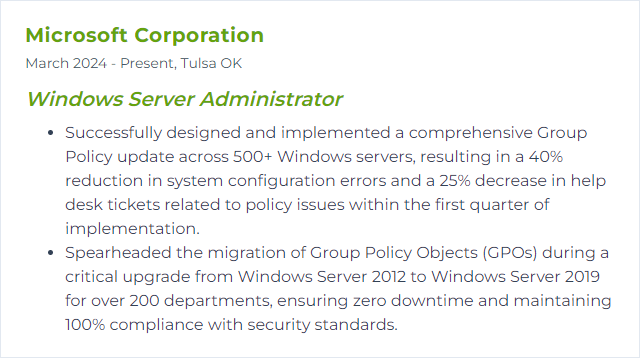
5. SCCM (System Center Configuration Manager)
SCCM (System Center Configuration Manager), now known as Microsoft Endpoint Configuration Manager, is a systems management software product by Microsoft for managing large groups of computers running Windows OS. It allows Windows Server Administrators to deploy OSes, applications, and updates, enforce compliance settings, and monitor system status across all managed devices within an organization.
Why It's Important
SCCM is important for a Windows Server Administrator because it centralizes the management of devices and applications across an organization, streamlining deployment, updates, and compliance settings, thereby enhancing system security and efficiency.
How to Improve SCCM (System Center Configuration Manager) Skills
Improving SCCM (System Center Configuration Manager) involves several key steps focused on optimization, maintenance, and leveraging advanced features. Here's a concise guide for a Windows Server Administrator seeking to enhance their SCCM environment:
Optimize Performance: Regularly review and adjust the SCCM infrastructure for optimal performance. This includes database maintenance, site system roles optimization, and client health. Microsoft provides guidelines for Performance Tuning Guidelines for Windows Server.
Automate Maintenance Tasks: Use PowerShell scripts to automate routine SCCM maintenance tasks such as cleanup jobs, health checks, and backups. Microsoft's Script Center is a valuable resource: TechNet Script Center.
Implement Role-Based Administration (RBA): Fine-tune access controls and permissions for various administrative roles within SCCM to enhance security and operational efficiency. Microsoft's documentation on Role-Based Administration offers a detailed guide.
Stay Updated: Regularly update SCCM to the latest version to benefit from new features, security enhancements, and performance improvements. Microsoft's guide on Updating Configuration Manager provides a step-by-step process.
Leverage Cloud Services: Integrate SCCM with cloud services like Microsoft Azure and Windows Update for Business to extend its capabilities, improve scalability, and enhance disaster recovery options. The guide on Integrating with Azure Services can help you start.
Monitor and Report: Actively monitor SCCM operations and generate reports to track system health, compliance, and deployment status. Utilize SCCM's built-in reporting features and consider integrating with Power BI for advanced analytics. Information on Asset Intelligence and Reporting in SCCM is useful.
Improving SCCM is an ongoing process that involves staying informed about the latest features, best practices, and community insights. Engaging with the SCCM community through forums such as Reddit's SCCM subreddit can provide valuable tips and support.
How to Display SCCM (System Center Configuration Manager) Skills on Your Resume
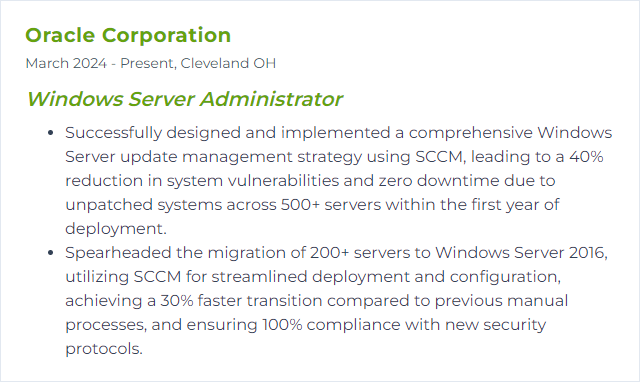
6. IIS (Internet Information Services)
IIS (Internet Information Services) is a flexible, secure, and manageable web server from Microsoft that is used for hosting websites, services, and applications on Windows Server environments.
Why It's Important
IIS is essential for a Windows Server Administrator because it enables the hosting and management of websites, applications, and services on Windows Server, ensuring secure, scalable, and accessible web infrastructure.
How to Improve IIS (Internet Information Services) Skills
Improving IIS performance involves several key steps focused on optimization, security, and monitoring. Here's a concise guide:
Enable Compression: Reduce load times by compressing static and dynamic content. IIS Compression.
Use Caching: Implement content caching to reduce server load and improve response times. IIS Output Caching.
Optimize Application Pools: Configure and recycle application pools to manage resources efficiently. Application Pool Configuration.
Update and Patch: Regularly update IIS and the underlying Windows Server to ensure security and performance. Windows Server Update Services.
Enable HTTPS: Secure your site with SSL/TLS to protect data and improve SEO. SSL on IIS.
Monitor Performance: Use tools like IIS Manager and Performance Monitor to track and optimize server performance. Using Performance Monitor.
Fine-tune Security Settings: Implement security best practices to protect your server against threats. IIS Security.
Manage Bandwidth and Connections: Set limits to prevent overuse of resources. Throttling Bandwidth in IIS.
By following these steps and continually monitoring and adjusting based on performance metrics, you can significantly improve the efficiency and security of your IIS deployment.
How to Display IIS (Internet Information Services) Skills on Your Resume

7. Azure AD
Azure AD (Azure Active Directory) is Microsoft's cloud-based identity and access management service, enabling secure sign-in and authorization for services and applications in the cloud and on-premises environments.
Why It's Important
Azure AD is crucial for a Windows Server Administrator because it enables centralized management of user identities and access across cloud services and Windows Server environments, enhancing security and simplifying administrative tasks.
How to Improve Azure AD Skills
To improve Azure AD, follow these concise strategies:
Enable Multi-Factor Authentication (MFA): Enhance security by requiring two or more verification methods. Enable MFA
Use Conditional Access Policies: Define conditions under which users can access Azure AD resources. Conditional Access Documentation
Implement Role-Based Access Control (RBAC): Minimize risks by giving users the least privileges they need. Understand RBAC
Regularly Review and Audit Sign-in Logs: Monitor and analyze sign-in logs to detect suspicious activities early. Sign-in logs in Azure AD
Keep Azure AD and Windows Server Synchronized: Use Azure AD Connect to keep your on-premises and cloud directories in sync. Azure AD Connect
Educate Users on Security Practices: Train users on recognizing phishing attempts and securing their login credentials. Security Awareness Training
Implement Privileged Identity Management (PIM): Manage, control, and monitor access within Azure AD to reduce risks of excessive privileges. Azure AD PIM
By systematically applying these practices, you can significantly enhance the security and efficiency of your Azure AD environment.
How to Display Azure AD Skills on Your Resume
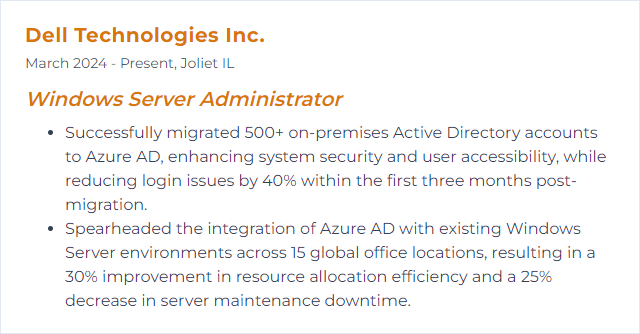
8. WSUS (Windows Server Update Services)
WSUS (Windows Server Update Services) is a Microsoft server role that enables administrators to manage and distribute updates for Microsoft products to computers in a corporate environment, ensuring systems are kept up-to-date and secure.
Why It's Important
WSUS is important for a Windows Server Administrator because it centralizes the management and deployment of Windows updates and patches, ensuring networked devices are consistently secure and up to date, thereby reducing vulnerabilities and improving network reliability.
How to Improve WSUS (Windows Server Update Services) Skills
Improving WSUS involves optimizing performance, ensuring security, and maintaining operational efficiency. Here are concise strategies:
Optimize WSUS Database: Regular maintenance of the WSUS database can improve performance. Consider re-indexing and defragmenting the WSUS database. Microsoft Doc on WSUS Maintenance
Clean Up WSUS: Use the WSUS Cleanup Wizard to remove unnecessary updates, freeing up disk space and improving server performance. Cleanup Wizard
Configure Client Targeting: Use Group Policy or registry settings to organize computers into groups for more efficient update management. Client Targeting
Adjust Bandwidth Usage: Limit WSUS download speeds during business hours to minimize network impact. Consider using BITS (Background Intelligent Transfer Service) policies. BITS Configuration
Secure WSUS with SSL: Implement SSL to secure communication between WSUS servers and clients. SSL Configuration
Automate WSUS with PowerShell: Use PowerShell scripts to automate common WSUS tasks, such as cleanup, approval, and reporting, thereby improving efficiency. Automating WSUS with PowerShell
Monitor WSUS Performance: Regularly monitor WSUS performance and troubleshoot issues promptly to ensure smooth operation. Utilize Event Viewer and performance counters. Monitoring WSUS
Keep WSUS Updated: Ensure that WSUS itself is up to date with the latest features and security patches to improve performance and security. WSUS Updates
By following these strategies, a Windows Server Administrator can significantly enhance the performance, security, and efficiency of WSUS in their environment.
How to Display WSUS (Windows Server Update Services) Skills on Your Resume
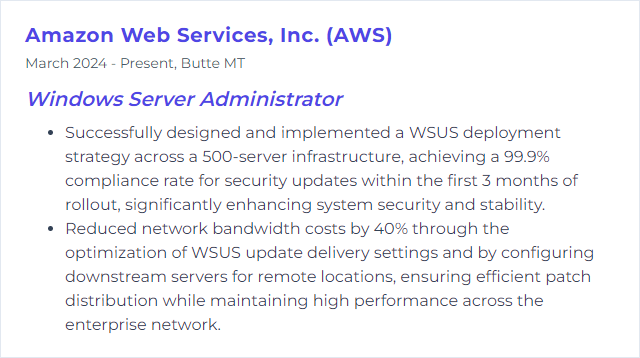
9. DNS Management
DNS Management involves configuring and maintaining the Domain Name System (DNS) settings on a Windows Server to ensure that domain names are correctly translated to IP addresses, enabling networked devices to locate and communicate with each other effectively. This process includes managing DNS zones, records, and server settings.
Why It's Important
DNS Management is crucial for a Windows Server Administrator because it ensures network users can reliably and quickly find resources and services by translating domain names into IP addresses, facilitating efficient network communication and resource access.
How to Improve DNS Management Skills
Improving DNS management involves optimizing performance, enhancing security, and ensuring high availability. Here are concise strategies for a Windows Server Administrator:
Regularly Update DNS Server: Ensure your DNS servers are always updated to the latest version to benefit from improved features and security patches. Microsoft's Guide on Updating Windows Server
Implement DNSSEC: Secure your DNS queries using DNS Security Extensions (DNSSEC) to protect against cache poisoning and other DNS-related attacks. Configuring DNSSEC in Windows Server
Enable DNS Logging and Monitoring: Keep track of DNS server performance and security by enabling logging. Analyze logs regularly for anomalies. DNS Logging and Diagnostics in Windows Server
Use Forwarders and Conditional Forwarders Wisely: Forwarders can help improve resolution speed and manage traffic. Use conditional forwarders for specific domain queries. Configure DNS Forwarding in Windows Server
Implement Caching Strategies: Properly configure your DNS cache settings to improve resolution speed and reduce external DNS traffic. Understanding Caching in Windows DNS Server
Secure DNS against DDoS Attacks: Implement rate limiting, recursion control, and access control lists to mitigate the risk of DDoS attacks. Securing Windows DNS Servers
Split DNS Architecture for Internal and External Queries: Use split DNS to manage and secure internal and external DNS queries separately. Deploying Split DNS in Windows Server
Regularly Audit DNS Zones and Records: Periodically review and clean up stale DNS records and zones to prevent DNS hijacking and ensure optimal performance. Managing DNS Zones in Windows Server
By following these strategies, you can significantly improve DNS management on Windows Server, enhancing both performance and security.
How to Display DNS Management Skills on Your Resume
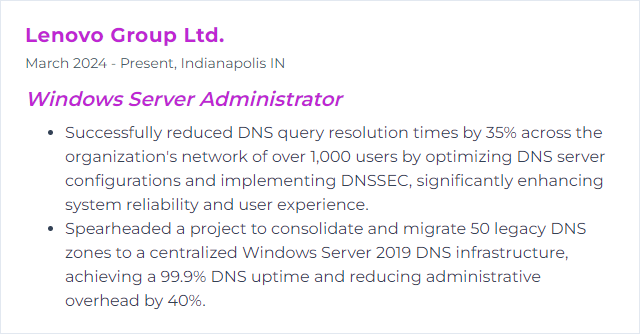
10. DHCP Configuration
DHCP (Dynamic Host Configuration Protocol) configuration involves setting up a DHCP server to automatically assign IP addresses and other network configuration parameters (such as subnet mask, default gateway, and DNS servers) to client devices on a network, reducing the need for manual network configuration and ensuring efficient management of IP addresses within a Windows Server environment.
Why It's Important
DHCP configuration is essential for a Windows Server Administrator because it automates IP address allocation, ensuring efficient network management, reducing manual configuration errors, and facilitating the seamless connection of devices to the network.
How to Improve DHCP Configuration Skills
To improve DHCP configuration on Windows Server, follow these concise steps:
Plan IP Address Range: Determine the scope of IP addresses that will be assigned by the DHCP server. Avoid conflicts with static IP addresses.
Configure DHCP Scopes: Create and configure DHCP scopes to manage the distribution of IP addresses and subnet information efficiently. Microsoft Docs - Manage DHCP Scopes
Set Lease Duration: Adjust the DHCP lease duration based on your network needs. Shorter leases for dynamic environments, longer for stable ones. Microsoft Docs - Configure Lease Duration
Reservations and Exclusions: Reserve IP addresses for devices needing a consistent IP address and exclude IP addresses that are statically assigned. Microsoft Docs - Configure Reservations and Exclusions
Configure DHCP Options: Set DHCP options to automatically provide clients with network configuration parameters such as DNS servers, router (default gateway), etc. Microsoft Docs - Configure DHCP Options
Enable DHCP Failover: Configure DHCP failover to ensure high availability of DHCP service. Microsoft Docs - Deploy DHCP Failover
Secure DHCP Server: Implement DHCP server security measures, such as DHCP Snooping on switches and enabling DHCP server audit logging. Microsoft Docs - DHCP Security
Regularly Monitor and Audit: Use tools and logs to monitor DHCP server performance and audit IP address allocations to ensure optimal operation. Microsoft Docs - Monitor and Audit DHCP Server
Backup and Restore DHCP: Regularly back up the DHCP database to quickly recover from failures. Microsoft Docs - Backup and Restore DHCP
Update and Patch: Keep your DHCP server updated with the latest patches and updates from Microsoft to ensure security and stability. Microsoft Update Catalog
Following these steps will help improve DHCP configuration and management on a Windows Server, enhancing network efficiency and reliability.
How to Display DHCP Configuration Skills on Your Resume

11. Failover Clustering
Failover Clustering in Windows Server is a high availability feature that allows multiple servers to work together to provide continuous service even if one or more of the servers fail. It ensures that applications and services can be quickly transferred to another server in the cluster without downtime, minimizing disruptions and maintaining data integrity.
Why It's Important
Failover Clustering is crucial for ensuring high availability and disaster recovery for critical applications and services by automatically transferring workloads to operational nodes in the event of a failure, minimizing downtime and service disruption.
How to Improve Failover Clustering Skills
To improve Failover Clustering as a Windows Server Administrator, focus on the following key areas:
Plan and Design: Properly plan your cluster, considering the number of nodes, storage options, and network configuration. Microsoft's Planning Guide is a great starting point.
Latest Updates: Ensure all cluster nodes are updated with the latest Windows Server updates. Regularly check Windows Update for the latest patches.
Validate Configuration: Use the Validate a Configuration Wizard in Failover Cluster Manager to check your cluster's configuration for any issues. See Validate Configuration Wizard.
Performance Monitoring: Monitor your cluster performance regularly using Performance Monitor (PerfMon) and address any bottlenecks or issues. Check Performance Monitoring for guidance.
Quorum Configuration: Choose the appropriate quorum configuration for your cluster to ensure maximum availability. The Quorum in Windows Server document explains the options and their benefits.
Backup and Disaster Recovery: Implement a robust backup and disaster recovery plan. Use tools like Windows Server Backup or third-party solutions. Backup Solutions provides more information.
Security Best Practices: Follow security best practices for Failover Clustering, including network security, user permissions, and encryption. The Security and Protection guide offers detailed advice.
Training and Documentation: Stay informed about the latest features and best practices by accessing Microsoft's official documentation and training materials. The Failover Clustering Documentation is an excellent resource.
By focusing on these areas and utilizing the resources provided, you can significantly improve the reliability, performance, and security of your Failover Clustering environment.
How to Display Failover Clustering Skills on Your Resume
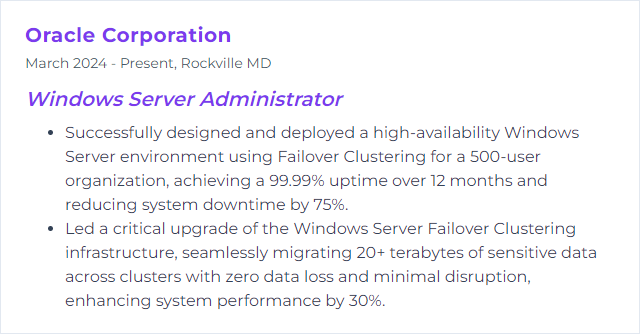
12. SQL Server
SQL Server is a relational database management system developed by Microsoft, designed to store, retrieve, and manage data in a structured format, supporting a wide range of transaction processing, business intelligence, and analytics applications in corporate IT environments. It runs primarily on Windows Server platforms.
Why It's Important
SQL Server is essential for a Windows Server Administrator because it provides a robust, scalable, and secure data management platform for storing, retrieving, and managing critical enterprise data across various applications and services within a Windows Server environment.
How to Improve SQL Server Skills
Improving SQL Server performance involves several strategies focusing on optimization and maintenance. Here are concise recommendations:
Update SQL Server: Ensure your SQL Server is up to date with the latest service packs and patches. Microsoft Update Catalog
Optimize Indexes: Regularly review and optimize indexes; rebuild fragmented indexes and remove unused or duplicate indexes. Index Maintenance
Query Performance: Analyze and optimize slow-running queries using Execution Plans. Query Tuning
Configure TempDB: Properly configure your TempDB for optimum performance. Consider placing TempDB on a fast I/O subsystem. TempDB Configuration
Memory Allocation: Ensure SQL Server has enough memory allocated and it's not competing with other services. Adjust maximum server memory as needed. Server Memory Configuration
Monitor and Analyze: Regularly monitor SQL Server performance using tools like SQL Server Management Studio (SSMS), Performance Monitor, and Extended Events. Monitoring SQL Server
Database Maintenance Plans: Create maintenance plans for tasks such as updating statistics, checking database integrity, and performing regular backups. Maintenance Plans
Enable Instant File Initialization: Reduce the time required for file growth operations. Requires performing security considerations. Instant File Initialization
By following these tips and keeping abreast of SQL Server best practices, you can significantly improve the performance and reliability of your SQL Server instances.
How to Display SQL Server Skills on Your Resume
